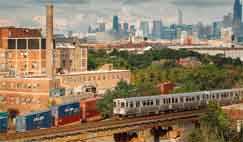The enormous log jams at the ports of Los Angeles and Long Beach have literally been transported to the Midwest, with key transfer hub Chicago awash in containers, causing significant delays.
Supply Chain Digest Says...
|
 |
| The moves by Union Pacific and BNSF to stop or slow movement of containers to Chicago has the effect of pushing the problem back to already heavily congested West Coast ports. |
 |
What do you say? |
| Click here to send us your comments |
 |
| Click here to see reader feedback |
|
Chicago is the leading hub for handling containers arriving via train from West Coast ports, where the boxes are loaded on to trucks for moves to the final destination or loaded on to another train.
But now, the Wall Street Journal reports, the volumes of containers are so high they are arriving faster than the can be processed at the rail yards. Another issue is a lack of chassis to move containers from rail yards to loading points.
Rather than a single movement from train to truck, containers now are lifted off, placed in storage and then moved a second or even third time before eventually exiting the yard, Lawrence Gross, a transportation consultant in Durango, Colo., told the Washington Post.
With containers piling up, “The strains are being exacerbated by labor and equipment shortages across the shipping, trucking and rail industries” the Journal article notes.
In response, Union Pacific and BNSF Railway, the two main rail carriers of containers coming from West Coast ports, have both limited container shipments into their terminals in the Chicago area.
What’s more, some shippers and logistics firm have been diverting containers by truck or rail to other Midwestern transfer hubs, such as Kansas City, St. Louis, or Memphis. That increases costs and adds more complexity. And these other transfer points are also choking on volumes, though perhaps not as bad as Chicago.
In the face of all that, Union Pacific last week halted all eastbound traffic from the ports of Los Angeles, Long Beach, Oakland and Tacoma, starting July 19, for at least one week.
And BNSF Railway announced it was reducing the flow of containers from Los Angeles and Long Beach for two weeks.
“This particular situation is somewhat unprecedented in that for a sustained amount of time the volume we are getting is exceeding what customers are picking up from our gates for deliveries,” BNSF said in a statement.
Both railroads have also made more room for containers that must be temporarily stored. Union Pacific reopened a terminal in Rochelle, Ill., that it closed two years ago, while BNSF paved over two tracks to create space at a 638-acre facility in Chicago it calls the nation’s largest inland port.
(See More Below)
|
CATEGORY SPONSOR: SOFTEON |
|
|
| |
|
|
And rail carrier Norfolk Southern, which moves containers from Chicago to East Coast markets, announced this week that it was expanding capacity at its intermodal terminal in Chicago by rearranging various yard operations.
 All this is exacerbated by Chicago’s unique role in the transport of containers. All seven of the major North American freight railroad connect to hubs there, resulting in lots of operational complexity as inbound and outbound shipments are synced with outbound trains and trucks. All this is exacerbated by Chicago’s unique role in the transport of containers. All seven of the major North American freight railroad connect to hubs there, resulting in lots of operational complexity as inbound and outbound shipments are synced with outbound trains and trucks.
While transporting containers by truck all the way from the West Coast to Eastern markets is a lot more expensive than rail, right now it will probably reduce transit times by a week versus rail, experts say.
The moves by Union Pacific and BNSF to stop or slow movement of containers to Chicago has the effect of pushing the problem back to already heavily congested West Coast ports.
About 40 of the three-mile-long trains that would typically travel from Long Beach to Chicago were canceled last week, meaning that perhaps 25,000 containers that should have already left for the Windy City are still stuck in California, the Post reports.
Any thoughts on the back up of container traffic in Chicago? Let us know your at the Feedback section below.
|
|
Brandon Hovey
CEO, Amafruits |
Posted on: Jul, 29 2021 |
|
| Are the issues moving on rail from east coast ports as bad? |
|
|